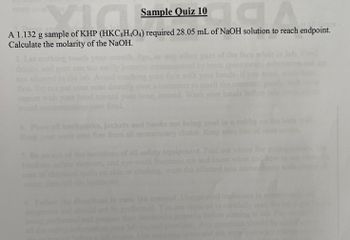
Chemistry
10th Edition
ISBN: 9781305957404
Author: Steven S. Zumdahl, Susan A. Zumdahl, Donald J. DeCoste
Publisher: Cengage Learning
expand_more
expand_more
format_list_bulleted
Concept explainers
Question

Transcribed Image Text:Sample Quiz 10
aga
A 1.132 g sample of KHP (HKC8H4O4) required 28.05 mL of NaOH solution to reach endpoint.
Calculate the molarity of the NaOH.
tou
no
first. Do
Vacu
4.
Keep
5.
dan
being
directly
oward your
food.
out
Instead. Wash your
ks, jackets and books not being us
free from all unnecessa
Ke
**
Expert Solution
This question has been solved!
Explore an expertly crafted, step-by-step solution for a thorough understanding of key concepts.
Step by stepSolved in 2 steps with 2 images

Knowledge Booster
Learn more about
Need a deep-dive on the concept behind this application? Look no further. Learn more about this topic, chemistry and related others by exploring similar questions and additional content below.Similar questions
- Calculate the weight of a solution with a solid solute of 370% (w/w) NH4NO3 (100g).arrow_forwardPart 1. One gram of caffeine dissolves in 55 ml of water; 7 ml of dichloromethane (DCM); 530 ml of diethyl ether; and 100 ml of benzene. Covert the solubility of caffeine in these four solvents into units of mg/ml. a) Solubility of caffeine in mg/ml in water: b) Solubility of caffeine in mg/ml in DCM: c) Solubility of caffeine in mg/ml in Diethyl Ether: d) Solubility of caffeine in mg/ml in Benzene: Which is the optimal solvent to extract caffeine from an aqueous solution? Why? Part 1 Continued: Use intermolecular force (IMF), provide a brief explanation on the solubility of caffeine in water, diethyl ether, observed above. (Hint: draw the skeletal structures for caffeine, DCM and diethyl ether)arrow_forwardChromium (III) chloride forms a hexahydrate, CrCl3*6H2O (s). How many grams of CrCl3*6H2O (s) are needed to prepare 250 milliliters of an aqueous solution that is .500 M in Cr3+ (aq)?arrow_forward
- Calculate the molarity of 163 grams of sucrose, C12H22O11, in 1.20 liters of solution.arrow_forwardA student has a solution that contains 48.1 mg of PNP (MW = 139 g mol-1) in 650 mL of 45.0 % ethanol. Calculate the concentration of PNP in the solution (in µM).arrow_forward2. Using the data given below, calculate the percentage of KHP in the impure sample. The molar mass of KHP is 204.219 g/mol. Molarity of NaOH Solution: Mass of Unknown: Volume of Water Used to Dissolve Unknown: Volume of NaOH Used to Reach Equivalence Point: Percent of KHP: 0.1955 M 1.1801 g 30.00 mL 17.01 mL % Stolal Vol)arrow_forward
- I need help on this question please?arrow_forward10 mL of 6M HCl was diluted to 100mL. Calculate the concentration of the dilute solution.arrow_forward1.) You are asked to make 1500 mL of TE (1X) using TE (100X). The volume of water used is: a) 95 mL 1 b) 00 mL c) 500 mL d) 15 mL 2.) From 3 M Tris solution, how is 400 ml of 1 M Tris prepared? a) water 267 ml and 133 ml 3 M Tris b)267 ml c) water 267 ml d) 133 ml 3 M Trisarrow_forward
- calculate the final concentration when a 28.0 mL sample of 25% (m/v) sodium chloride solution is diluted to 250mL?arrow_forwardFor this question it’s telling me use KCI which stands for potassium chloride so do I use KCl, (1 atom X 39.0983 Potassium) + (1 atom X 35.453 Chlorine) = (74.5513 g/mol) and use that with 10 ML of 20% Solution. I’ve been stuck on figuring out what I could do for this question. I want a long clarification and steps on it so it could help me know if I’m correct as I’m doing this question on my notebook.arrow_forwardCalculate the molarity of a solution made by dissolving 10.0g of glucose (C6H12O6 1 mol = 180g) in a sufficient amount of water to form exactly 200 mL of solution. Show a brief calculation step using the numbers and the units provided in the question.arrow_forward
arrow_back_ios
arrow_forward_ios
Recommended textbooks for you
 ChemistryChemistryISBN:9781305957404Author:Steven S. Zumdahl, Susan A. Zumdahl, Donald J. DeCostePublisher:Cengage Learning
ChemistryChemistryISBN:9781305957404Author:Steven S. Zumdahl, Susan A. Zumdahl, Donald J. DeCostePublisher:Cengage Learning ChemistryChemistryISBN:9781259911156Author:Raymond Chang Dr., Jason Overby ProfessorPublisher:McGraw-Hill Education
ChemistryChemistryISBN:9781259911156Author:Raymond Chang Dr., Jason Overby ProfessorPublisher:McGraw-Hill Education Principles of Instrumental AnalysisChemistryISBN:9781305577213Author:Douglas A. Skoog, F. James Holler, Stanley R. CrouchPublisher:Cengage Learning
Principles of Instrumental AnalysisChemistryISBN:9781305577213Author:Douglas A. Skoog, F. James Holler, Stanley R. CrouchPublisher:Cengage Learning Organic ChemistryChemistryISBN:9780078021558Author:Janice Gorzynski Smith Dr.Publisher:McGraw-Hill Education
Organic ChemistryChemistryISBN:9780078021558Author:Janice Gorzynski Smith Dr.Publisher:McGraw-Hill Education Chemistry: Principles and ReactionsChemistryISBN:9781305079373Author:William L. Masterton, Cecile N. HurleyPublisher:Cengage Learning
Chemistry: Principles and ReactionsChemistryISBN:9781305079373Author:William L. Masterton, Cecile N. HurleyPublisher:Cengage Learning Elementary Principles of Chemical Processes, Bind...ChemistryISBN:9781118431221Author:Richard M. Felder, Ronald W. Rousseau, Lisa G. BullardPublisher:WILEY
Elementary Principles of Chemical Processes, Bind...ChemistryISBN:9781118431221Author:Richard M. Felder, Ronald W. Rousseau, Lisa G. BullardPublisher:WILEY

Chemistry
Chemistry
ISBN:9781305957404
Author:Steven S. Zumdahl, Susan A. Zumdahl, Donald J. DeCoste
Publisher:Cengage Learning

Chemistry
Chemistry
ISBN:9781259911156
Author:Raymond Chang Dr., Jason Overby Professor
Publisher:McGraw-Hill Education

Principles of Instrumental Analysis
Chemistry
ISBN:9781305577213
Author:Douglas A. Skoog, F. James Holler, Stanley R. Crouch
Publisher:Cengage Learning

Organic Chemistry
Chemistry
ISBN:9780078021558
Author:Janice Gorzynski Smith Dr.
Publisher:McGraw-Hill Education

Chemistry: Principles and Reactions
Chemistry
ISBN:9781305079373
Author:William L. Masterton, Cecile N. Hurley
Publisher:Cengage Learning

Elementary Principles of Chemical Processes, Bind...
Chemistry
ISBN:9781118431221
Author:Richard M. Felder, Ronald W. Rousseau, Lisa G. Bullard
Publisher:WILEY